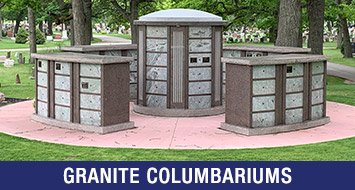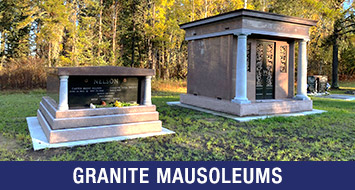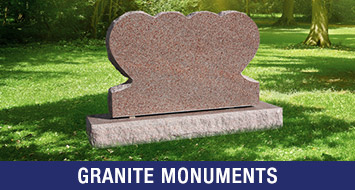Custom Granite Monuments - Premium Memorial Solutions
Nelson Granite creates exceptional custom granite monuments that serve as lasting tributes to cherished memories and important legacies. Our granite monuments, crafted from premium Canadian Shield granite, combine traditional stoneworking expertise with modern precision to create memorials that endure for generations.
Types of Granite Monuments We Create
Memorial Granite Monuments
Our memorial granite monuments encompass a comprehensive range of remembrance options designed to honor loved ones with dignity and beauty. From traditional headstones and grave markers to elaborate mausoleums and family memorials, each granite monument is carefully crafted to reflect the unique personality and legacy of those being remembered.
Memorial granite monument options include:
- Upright granite monuments with custom inscriptions
- Flat granite markers for ground-level placement
- Granite memorial benches for reflection and gathering
- Natural granite boulders with memorial elements
- Sculptural granite monuments reflecting personal interests
Commemorative Granite Monuments
Commemorative granite monuments play a vital role in preserving collective memories and educating future generations about historical events, cultural values, and important achievements. These granite monuments become focal points for community gathering and remembrance, offering permanence that digital memorials cannot match.
Notable examples of commemorative granite monuments include memorials like the Vietnam Veterans Memorial in Washington, D.C., which demonstrates how granite monuments can become powerful symbols of remembrance and gathering places for anniversary celebrations and educational activities.
Institutional Granite Monuments
Organizations including schools, hospitals, and civic institutions commission granite monuments to recognize major contributors, founding members, and significant supporters. These institutional granite monuments serve both commemorative and inspirational purposes, encouraging future generations to contribute to meaningful causes while creating lasting recognition for their support.
Why Choose Granite Monuments?
Granite Is Geologically Superior for Monuments
Granite monuments offer unmatched durability due to granite's unique composition of quartz, feldspar, and mica crystals. This crystalline structure gives granite monuments exceptional resistance to weathering, ensuring they maintain their appearance and structural integrity for centuries.
Canadian Shield granite used in our granite monuments has weathered millions of years of natural forces, proving its exceptional longevity. This proven durability translates directly to granite monument performance, as the stone continues to resist the same natural forces that shaped it over millennia.
Aesthetic Versatility of Granite Monuments
Granite monuments offer extraordinary design flexibility with an impressive range of granite colours and patterns. From classic grays and blacks to dramatic reds, blues, pinks, and greens, granite monuments can be customized to reflect personal tastes and complement specific settings. Our unique Morning Rose™ granite, also known as North American Pink™, provides distinctive color options exclusive to Nelson Granite monuments.
The natural variation within granite ensures that no two granite monuments are identical, creating truly unique memorials that stand apart from mass-produced alternatives.
Practical Advantages of Granite Monuments
Beyond aesthetics, granite monuments provide practical benefits that make them the preferred choice for lasting memorials:
- Low porosity makes granite monuments resistant to staining and water damage
- Superior hardness prevents scratching and chipping during normal handling and maintenance
- Thermal stability allows granite monuments to withstand extreme temperature variations without cracking
- Minimal maintenance requirements ensure granite monuments retain their beauty over decades
Custom Granite Monument Design Process
Our granite monument design process ensures each memorial perfectly captures your vision while meeting technical requirements and budget considerations. We work closely with families and organizations to create granite monuments that truly honor their intended purpose.
Design Consultation and Planning
Every granite monument project begins with comprehensive design consultation. Our experienced team collaborates with clients to understand their vision, incorporating personal elements, symbolic meanings, and specific requirements into the granite monument design. Computer-aided design (CAD) technology allows precise planning and visualization before any stone is cut, ensuring your granite monument meets expectations.
3D Visualization and Approval
Before manufacturing begins, we provide detailed 3D color renderings of your proposed granite monument. This visualization process allows clients to see exactly how their granite monument will appear, including all design elements, inscriptions, and finishing details. Modifications can be made at this stage to ensure complete satisfaction with the final granite monument design.
The Art and Science of Granite Monument Manufacturing
Granite Quarrying: From Nature to Monument
Our granite monuments begin deep within the Canadian Shield, where geological forces over millions of years have created some of nature's most durable and beautiful stone. Granite from Northwestern Ontario, including our quarry operations in Vermillion Bay, carries within its crystalline structure the essence of permanence that makes our granite monuments exceptional.
The quarrying process for granite monuments requires specialized equipment and expertise refined over generations. Diamond wire saws slice through massive granite formations with precision, while hydraulic splitters separate blocks along natural grain lines. Modern quarrying techniques minimize waste and environmental impact while maximizing the yield of high-quality stone suitable for granite monument creation.
Advanced Manufacturing Technologies
Contemporary granite monument manufacturing combines traditional stoneworking craftsmanship with cutting-edge technology. Computer Numerical Control (CNC) machines enable precise carving, cutting, and shaping that creates intricate granite monument designs with microscopic precision.
Wire saw technology provides smooth, clean cuts through granite blocks, creating perfectly flat surfaces and precise angles for granite monuments. This technology allows multiple monuments to be cut from single blocks with minimal waste, ensuring efficient use of premium granite materials.
Surface Finishing Excellence
Granite monuments can receive various surface treatments depending on the desired aesthetic and functional requirements. Polished surfaces provide mirror-like finishes that showcase the stone's natural beauty and color variations. Alternative finishes like matte or textured surfaces may be selected for their aesthetic appeal or functional properties, such as slip resistance for walkway granite monuments.
Granite Monument Installation Services
Professional granite monument installation ensures your memorial is properly positioned and secured for lasting stability. Our experienced installation team handles all aspects of granite monument placement, from site preparation to final positioning and alignment.
Site Preparation and Foundation
Proper granite monument installation begins with thorough site preparation. Our team evaluates soil conditions, drainage requirements, and cemetery regulations to ensure optimal placement. Foundation preparation for granite monuments includes proper leveling, drainage considerations, and compliance with all cemetery guidelines.
Professional Installation Process
Our granite monument installation process utilizes specialized equipment and techniques developed through decades of experience. Each granite monument is carefully positioned, leveled, and secured according to industry best practices and cemetery requirements. Final inspection ensures every granite monument installation meets our quality standards and client expectations.
Maintaining Your Granite Monument
While granite monuments require minimal maintenance due to granite's natural durability, proper care ensures optimal appearance and longevity. Regular cleaning and inspection help preserve the beauty of your granite monument for generations.
Routine Granite Monument Care
Maintaining granite monuments involves simple procedures that preserve their appearance and integrity. Gentle cleaning with appropriate stone cleaners removes dirt, biological growth, and environmental deposits without damaging the granite surface. Avoid harsh chemicals or abrasive materials that could compromise the finish of your granite monument.
Professional Maintenance Services
For comprehensive granite monument maintenance, professional restoration services can address weathering, staining, or damage that may occur over time. Professional maintenance ensures granite monuments continue to honor their intended purpose with dignity and beauty throughout the years.
Canadian Granite Monuments: Quality and Heritage
Canadian granite monuments represent exceptional quality and geological heritage. Our granite, sourced directly from the Canadian Shield, embodies millions of years of geological development, creating granite monuments with unmatched durability and distinctive beauty.
Northwestern Ontario Granite Excellence
Northwestern Ontario granite used in our monuments represents some of the world's oldest and most stable rock formations. This ancient stone, formed during the Precambrian era, provides the foundation for granite monuments that will endure for centuries. The unique geological characteristics of Canadian granite ensure our monuments possess exceptional strength, weather resistance, and visual appeal.
Frequently Asked Questions About Granite Monuments
How long do granite monuments last?
Properly crafted granite monuments can last for centuries with minimal maintenance. The durability of granite, combined with professional manufacturing and installation, ensures granite monuments remain beautiful and structurally sound for generations.
Can granite monuments be customized?
Yes, granite monuments offer extensive customization options including size, shape, color, finish, inscriptions, and decorative elements. Our design team works with clients to create unique granite monuments that perfectly reflect their vision and honor their intended purpose.
What makes granite monuments better than other materials?
Granite monuments offer superior durability, weather resistance, aesthetic versatility, and minimal maintenance requirements compared to other monument materials. The natural strength and beauty of granite make it the preferred choice for lasting memorials.
How much do custom granite monuments cost?
Granite monument pricing varies based on size, complexity, customization, and specific requirements. We provide detailed quotes that reflect the true value of creating lasting granite monuments that honor cherished memories for generations.
Investment in Legacy Through Granite Monuments
A granite monument from Nelson Granite represents more than a purchase—it's an investment in legacy and remembrance. While initial costs vary depending on size, complexity, and customization, the value of well-crafted granite monuments extends far beyond monetary considerations. These monuments serve families and communities for generations, providing immeasurable value as gathering places, teaching tools, and symbols of enduring love and respect.
The decision to create a granite monument reflects important values: the value of memory, the importance of honoring those who shaped our lives, and the desire to leave something permanent in an increasingly temporary world. Through skilled craftsmanship, advanced technology, and the enduring beauty of Canadian granite, our monuments become lasting testaments to the lives and legacies they commemorate.
The Nelson Granite Difference in Monument Creation
We know granite monuments intimately, quarrying granite directly from the Canadian Shield and manufacturing monuments in Northwestern Ontario. Our comprehensive approach to granite monument creation—from quarry to installation—ensures exceptional quality, authenticity, and value.
Learn more about Nelson Granite's heritage and watch our video demonstrations to see how we create granite monuments that honor life's most important memories and achievements.
Ready to Create Your Custom Granite Monument?
Contact our granite monument specialists to discuss your vision and learn how we can create a lasting tribute that honors what matters most.
Contact Our Monument Specialists






